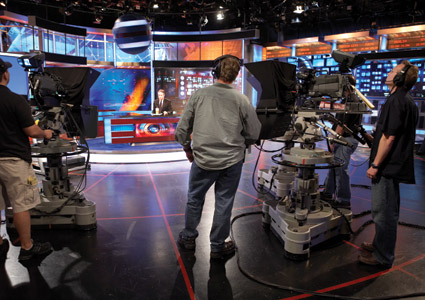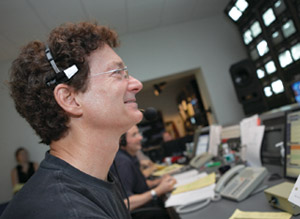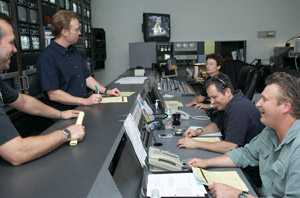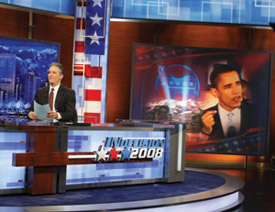BY ROB FELD
Photos by Kristine Larsen

 SHOWTIME: Stage manager Craig Spinney (top, center) gets his cues from
director
SHOWTIME: Stage manager Craig Spinney (top, center) gets his cues from
director
Chuck O'Neil (bottom) as they run through a rehearsal of that night's show.
It's a sticky and lethargy-inducing summer afternoon in New York, but there is an excitement underlying the otherwise quiet set of Comedy Central's The Daily Show. Former White House Press Secretary Scott McClellan is scheduled to be on this evening to promote his book, What Happened. Critical of the Bush White House, the book has been dominating the news cycle and this is going to be a big show. The program is devoting an unprecedented 2.5 acts to the interview (about 15 minutes). Receiving slightly less attention is the fact that it is also director Chuck O'Neil's eighth anniversary with the show, though there is some ribbing about gifts of lace and linen as O'Neil leads his crew through blocking rehearsal.
The Daily Show is arguably America's premiere forum for political satire, sometimes so tongue-in-cheek authoritative that it has itself become a prime news source for viewers. It is also a plum gig, renowned for its close-knit crew, great working environment and free lunches. The set is simple but versatile, with host Jon Stewart's anchor desk surrounded by projection screens that can double as green screens to do mock 'remotes' with correspondents. Televisions throughout the offices and control rooms at the Westside studio are tuned to CNN with the sound off, lending a counterpoint to a show that plays with the conventions of TV news.
It's a smooth-running operation and O'Neil's full schedule of production meetings and rehearsals leads up to the 6:15 taping. But there's still time to roll with whatever unforeseen punches the day may present before getting to final postproduction and the show's 11:00 p.m. airing. The structure, in fact, seems to allow for the creativity and spontaneity for which the show is known.
Something special is planned for McClellan's visit tonight. Fred Schneider of the B-52's, a flamboyant character with a loopy voice, is supposed to emerge behind McClellan during the interview to read passages from the book, the text of which will be projected on a screen behind him. The idea promotes mischievous giggles but it is presenting a blocking problem, which O'Neil, associate director Paul Pennolino and stage manager Craig Spinney are trying to work out with the three pedestals and one jib camera at their disposal.
O'Neil describes the setup to his crew and they tackle the issues. "The plan will change after rehearsal but at least I have the cameramen thinking about what we're doing, and I can get their input," explains O'Neil. "That's the nice thing about working here-everybody has the chance for input. We've worked together for a long time and I trust their judgments. They're also the ones on the floor moving the cameras around so they often have a better idea than I do."
The hope for the sketch is to have McClellan and Schneider in a single shot. If, however, McClellan decides to turn around to watch Schneider, his face has to remain in the frame, as does the text on the screen behind them both, not to mention Stewart himself. Spinney relays to Pennolino in the booth what O'Neil is doing on the floor and needs to see in the monitor. O'Neil then realigns the quotes projected behind Schneider, reframing and resizing the words to fit the shot. With some experimentation, they find a framing that works and Spinney sets marks. O'Neil will be in the booth during full rehearsal later in the afternoon, but is always on the floor for blocking.
 BALANCING ACT: O'Neil, who prides himself on being able to
BALANCING ACT: O'Neil, who prides himself on being able to
do a tight show on a first run, says the key to comedy is timing.
"By being out there I get to see exactly where the cameras need to be," he says, "and get a much better picture in my mind of what's going on, instead of sitting in the control room and just telling the cameras to move around. So by working with Craig and having Paul be myself in the control room, I get to envision it out there first, make sure it works, then go inside and work on it there if I need to."
O'Neil came to The Daily Show from Good Morning America not long after Stewart took over the reins from Craig Kilborn. He brought Pennolino with him and reunited with Spinney, who had been with The Daily Show since the Kilborn days and worked with O'Neil in 1994 on FX's Breakfast Time. The schedules on GMA were crushing and, at the gentle nudging of his wife, O'Neil jumped at the chance when he heard The Daily Show was looking for someone with strong live television experience and the ability to do big remotes from events like the recent political conventions (see sidebar).
"They brought us over here to give them the ability to do things with a short turnaround in trucks and remotes," says Pennolino. "We used to have one online editor, who would do all the headlines, but the whole building has now adapted, and continues to adapt, to Jon and the writers' rabid creative whims. Now we've got five Avid rooms going. Two of them are primarily dedicated to the day's headlines, but there are at least three rooms normally dedicated to field pieces. Jon may sit down and you can see the creative wheels spinning-and that's when you know it's time to cancel your evening plans."
After the blocking rehearsal, the script and rundown are delivered to O'Neil from Stewart and the writers, who have been working on it since morning, and O'Neil marks it up in time for the 3:45 camera production meeting in the booth, where he goes over the entire show with the whole crew.
 CLOCKWORK: After working together for eight years, O'Neil (rear),
CLOCKWORK: After working together for eight years, O'Neil (rear),
associate director Paul Pennolino (center) and Spinney
are a well-oiled machine.
"Jon's going to ask Fred if he wants to lead us to break," he says to the room. "Fred comes on, Camera 3 has a two-shot, Jon and Fred. We hit 'Love Shack,' he'll throw us to break and you can make a nice move off the two-shot." When the camera department asks O'Neil for a clarification about the proposed shot he reconsiders, "Well, you can just keep Jon and drift across." After the lighting department has a question answered regarding a lighting maneuver when Schneider emerges, the meeting continues onto Act II. And so on...
At 4:30, the crew takes its position for rehearsal and Stewart steps out of the writers' offices and onto the set for the first time, to run through the show.
When everyone has settled, O'Neil says "Count it, Paulie."
Pennolino hits his stopwatch and The Daily Show's date announcement and opening horns roll. And at the count of one, the theme music's guitar kicks in.
"Start your move," O'Neil calls. "Stand by Camera 3. Stand by P3. De-solveee..."
And rehearsal is off and running for a few seconds until Stewart calls for a "Daily Show Exclusive" graphic to be mocked-up, to spoof the fact that McClellan has already hit every other outlet on television.
The script times out right on this particular day, but it's frequently 5.5 minutes over, which means rehearsal would be spent getting it down to 22:30 minutes. "If we go into the show heavy," O'Neil explains, "we know the edit won't work. So a lot of times we have to re-shoot the whole opening."
The gremlin today, however, is Schneider's bit, and O'Neil has to roll with it as it evolves in rehearsal. As Schneider recites an extended passage of McClellan's writing, he struggles to find a rhythm. Stewart asks for a musical beat to be played and suggests Schneider make his delivery more sing-songy. O'Neil gives the cue, the crew pipes in a beat and the control room breaks up as Schneider nails it with a "Scoo-ooter Libbyyy...!" cheer that only he could sell. That locked in, O'Neil gives instructions to the control room and moves the session along.
Though the timing of the sketches can change from morning meeting to taping, O'Neil's crew adjusts without a hitch. "There's time to conceptualize an idea here and really bounce things off each other and bring it to a nice fruition," explains Pennolino. "Very often it feels like you're doing the 5 or 11 o'clock news because things are changing so rapidly and Jon wants to go as close to 6 o'clock as possible. Once he puts that suit on at a quarter to 4, he's in show mode, and everybody feeds off that. It's not live but you don't want to screw up because he's sitting in the chair and you don't want to do the joke twice, since the audience has already seen it. You want to do your best for him because he's bringing his triple-A game every time."
O'Neil prides himself on being able to do a clean and tight show on a first run. "I had done only live shows prior to this one, so it was one and done, on its way to Mars and there was nothing you could do about it," he jokes. "That being said, there are always things that come up, but Jon is so good, I don't recall him making mistakes. He might change roll cues on me a little bit, but if you're listening and paying attention, he's just led you to that piece of tape that's coming up, anyway.
"I guess the biggest problems we've had are either technical problems, where we've had a machine go completely down," O'Neil continues. "There were not a lot of times where we had to bust or retape something. Jon knows that if there's a problem and the cue doesn't roll, we have the tape and can lay it in during post, so he just keeps going."
When O'Neil emerges from the post-rehearsal rewrite meeting, the decision had been made to use Schneider in the first act introduction but not to push it in the second, having him come out behind McClellan as they had blocked for earlier. "It worked well as its own entity in Act I and there was no need to bring him back with McClellan. It could have very easily knocked McClellan off his train of thought, thrown him for a misdirect with Fred coming out behind him. It would have taken away the seriousness of the interview."
There's a lot to balance with this show, which sees itself, first and foremost, as a comedy program, despite the importance everyone seems to attach to the work. "I think the key to comedy is timing," O'Neil says of his efforts. "There's a place to give a breath. I do like all the tape rolls to be tight but there are times where I want it to sink into the audience before I hit the tape, so I may delay the tape a little bit. That, I think, is a crucial part of the timing; the way we make camera cuts, the way the joke is set up. I think, as a director, I try and put the emphasis where it needs to be. I'll hold on a graphic or on Jon a touch longer. Jon pretty much trusts me and is funny about letting something breathe.
For example, he recalls the first time Steve Carell, who started out on the show, came back for a visit. "He came out and they just sat there looking at each other. Steve lifted a cup, had a little water. And they didn't say anything for I think a minute and 45 seconds. Jon loves to let things percolate, to get people uneasy. I remember the first couple of years he'd say to me, 'Just hold on it a little longer,' when it was beginning to feel uncomfortable to me."
A signature part of The Daily Show is the fake green screen "remotes" in which correspondents pretend to be on a location that is projected on a tape behind them. Spinney, who's responsible for bringing the show's cast out on time to do the green screen says, "If the audience is listening to Jon but then gets distracted by something happening off-camera, it's disconcerting for the host who's trying to make them laugh. So I wait until the last second, but you've got to consider the camera guy's job too, to get framed up and focused. You've got to make sure everybody has what they need. It's all by feel. Every stage manager works differently. My style is speak softly and carry a big stick. Nobody needs a reminder of what they need to be doing."
When the revised, post-rehearsal rundown comes out O'Neil does his 6:00 production meeting with the camera department, tech director, audio, and tape, to make sure everyone is still on the same page. O'Neil gets the tapes and sends Stewart to meet McClellan, and the show is now an unstoppable train, heading for its 6:15 taping. "Jon is very much in tune with the flow and the process," O'Neil says. "He understands that from early in the day everything has to work like clockwork. When my script coordinator starts getting me the new scripts and rundowns, Jon has a built-in clock and knows. He talks to the booker about the guest, meets the guest, greets the audience and sits down and we do the show."
When the news clip tapes are all in and ready, O'Neil signals Spinney, who signals Stewart, and the show kicks off. It does, indeed, run like clockwork. The "Daily Show Exclusive" graphic hits its mark as planned when O'Neil calls for it, taking his cue from Stewart, but then Stewart seems to call for it again, and it isn't there. Instead, Stewart plays it off as a production foul-up and keeps going.
"There was supposed to be graphic to go over the lower third of the screen, as well," O'Neil later explains, "but we didn't communicate too well about when that was going to be. I expected it to be later on in Act II, leading in to McClellan, but then Jon called for it immediately. I never expected it to be there at that exact moment. We toyed with possibly putting it in later, but the way Jon reacted when it didn't come was funny, so we left it. A lot of times he'll make jokes at the expense of the production staff, which is also part of the satirical conceit."
The show wraps but the good thing about current events is that there will be plenty of news to skewer the next day. "This is the greatest place I could ever be," O'Neil says. "Eventually, you know these things come to an end and you're forced to go off and do something else. You hope it's going to be as good but you know in your mind that was the Holy Grail. This is one of those places."
BY CHUCK O'NEIL
 (Credit: Frank Micelotta/Getty Images)
(Credit: Frank Micelotta/Getty Images)
I arrived in Denver the Wednesday before the convention. The lights had been pre-hung so we loaded the sets and made sure everything would work the way we planned on paper.
On Friday the remote truck pulled in and we loaded the cameras and cables into the venue. To make everyone as comfortable as possible, we virtually took our whole show on the road and used most of the same equipment.
We knew going in that the venues were going to be tight. When we scouted for locations in Denver and St. Paul, our intention from the onset was to find intimate spaces. Experience has taught us large audiences create too much applause, which eats time away from the show's content. And as intoxicating as applause is, too much is not in the best interest of the home audience.
So the challenge for me at both venues was floor space for my cameras and crew, which I have to say was the smallest amount of space possible to do the production. The solution in Denver was to put my jib up in the balcony with a 24-foot arm, allowing me to have another lens without taking up any critical physical space on the floor.
On Saturday my camera guys came in and we started looking at camera positions. Sunday and Monday we had full blocking and lighting look-sees. We rehearsed the opening night sketch-a spoof of the old 'Wazzup' Budweiser beer ad-because it had complicated elements. The sketch called for five correspondents on the floor at the same time, faking broadcasts from multiple locations. So having the jib camera in the balcony enabled me to have a fifth camera in the small space on the floor, which was crucial. The choreography was a bit tricky, with everyone vying for space between two green-light-generated screens. With Jon in the middle, all of the correspondents had to come out and hit their marks within feet of him. It was like a play for the studio audience, with all the principles on stage at the same time.
The first Tuesday night in Denver, Virginia Governor Tim Kaine sat at the desk with Jon. Wednesday we had our only non-studio guest, DNC Chairman Howard Dean from the convention hall, so we had to use a satellite hookup, which meant a transmission delay. More often than not this can create an awkward dance between participants occasionally speaking over each other, and this interview was no exception.
Our venue at the University of Denver was about 10 minutes by car from the convention center, but in St. Paul we were pretty much in the fray, just a few blocks away from the perimeter. We had a couple of major demonstrations enveloping our remote truck, where my control room was.
On Thursday night, as McCain was accepting the nomination, Mike Huckabee was in the studio. It was kind of a pain for me dealing with all the hoopla going on outside the truck. The din of the police helicopters hovering over us, and the arresting of protesters made it difficult to hear and concentrate on what was going on in the control room.
All in all, the experience of the conventions was pretty straight-forward. I literally looked at every possible scenario before we went into production. The workings of The Daily Show are like a machine, and we just crank it out. Everyone on staff felt like we had two of the best weeks we've had in long time, and we were on a high coming home.